How Deep Is the Ocean?

Any ocean depth greater than 200 meters is considered deep sea. The average depth of the World Ocean is 3.5 km. However, the deepest known part of the World Ocean is Challenger Deep, which has a depth of about 11 km. Challenger Deep is located in the southern end of the Mariana Trench, in the Pacific Ocean, 700 kilometers southwest of Guam. In addition to Challenger Deep, there are four other deep points in the western Pacific Ocean: Philippine Trench, Tonga Trench, Kermadec Trench, and Kuril-Kamchatka Trench.
Categories of Ocean Depths
There are four divisions of the deep sea ocean: the littoral, bathyal, abyssal, and hadal zones. The littoral zone ranges from the ocean's surface to 0.2 km deep. The bathyal zone ranges from 0.2 km to 3km deep, while the abyssal zone ranges from 3 km to 6 km deep. Depths beyond 6 km are referred to as the hadal zone. “Hadal” comes from the word 'hades" which is a mythological term used to refer to the abode of the dead, and refers to the Greek the god of the Underworld, who was the brother of Zeus and Poseidon.
The Hadal Zone
The hadal zone includes a series of 33 disjointed trenches around the world. This zone makes up only 0.2% of the ocean floor, but accounts for 45% of the total depth range of the oceans. The mean depth of these trenches is 8.216 km, and their formation occurred through a process known as tectonic plate subduction. Temperatures within the deepest trenches range between 1 and 4 degrees Celsius. Examples of marine life that live in the deep oceans include prawns (7,000 meters deep), snailfish (7,400 meters deep), and cusk eel (6,500 meters deep). Other creatures include sea cucumbers, snails, hoppers, worms, red prawns, and little pink fish. Most of the hadal fauna inhabit the trenches and are unable to migrate to other parts of the oceans.
Exploration of the Deepest Part of the Ocean
The Challenger Deep was named after the British naval ship HMS Challenger, whose crew discovered this deepest point of the ocean in 1875. The HMS Challenger expedition occurred between 1873 and 1876. The ship's team collected sediments from depths of at least 8 km. In 1901, the Princess Alice expedition resulted in the excavation of another specimen from depths of greater than 6 km. A Swedish expedition was even more successful in the trawling of a variety of species, which came from 7-8 km deep waters in the Puerto Rico Trench. The Swedish explorers provided proof of the existence of marine life beyond depths of 6 km. In spite of these many expeditions, no photographs existed until Jacques Cousteau explored the hadal zone 1956, capturing photos in the Atlantic Ocean's Romanche Trough.











